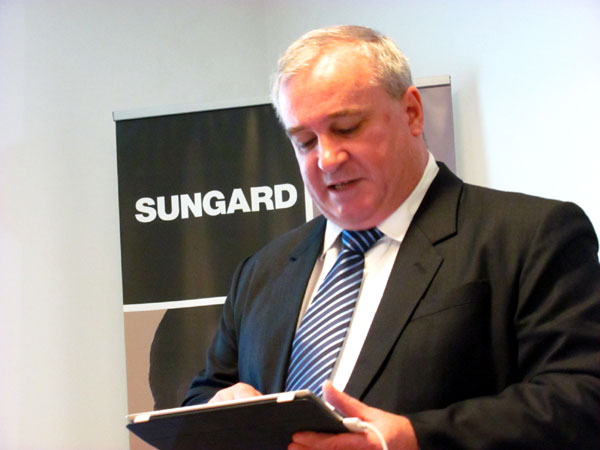
Dean Young, SunGard’s Vice President for Product Management, discusses the results of their study that found majority of banks are not ready for global trends that are shaping consumers’ expectations from banks. Photo by Matikas Santos
MANILA, Philippines – Imagine adding your bank as a friend in a social networking site, chatting about what you can do with your hard-earned deposits, checking out your account details on your mobile phone, and then walking into a branch to finalize a deal with the manager.
These services, however, are not yet being provided by banks despite their readily available and widespread adaptation of technology, according to the study by international software and technology solutions provider SunGard and research group Celent.
According to the Bank Readiness Index (BRI) study released by SunGard, banks have not been able to fully adapt to the changing needs of their customers who are social media-savvy and have mobile devices.
Dean Young, SunGard’s Vice President for Product Management, shows the Bank Readiness Index Survey that measures a bank’s readiness for ongoing global trends that affect their customers. Photo by Matikas Santos
“Around one-third of banks use social media to some degree. More for marketing and less for customer service – just the opposite of what consumers said they preferred,” the BRI study said.
“Few [banks] have an integrated social media plan and fewer still have integrated social media into Customer Relationship Management (CRM), Business Process Management, and compliance systems,” the study said.
Dean Young, SunGard’s Vice President of Product Management, said in his presentation that the BRI was conducted in order to identify global trends affecting banks and their customers and to assess their readiness for these trends.
He said that they wanted to know if the services being offered by banks matched the expectations of consumers, especially now with a rapidly changing technology landscape that give people more capabilities to connect with each other.
They interviewed 102 banks and 1073 bank customers in eight countries, four from the Middle East: Kuwait, Qatar, Saudi Arabia, United Arab Emirates, and four from Southeast Asia: Indonesia, Malaysia, Philippines, and Thailand.
The BRI ranks countries on a scale of 1 to 1000, with 1000 being the best, to measure their readiness to adapt to global trends. The banks were measured in four aspects: Mobility, Multichannel, Social Media, and Customer Metrics.
Philippines had a score of 236 while Indonesia scored 231, Malaysia 285, and Thailand 263. A BRI score of 350 and below was categorized as a “Technology Laggard.”
“The Technology Laggard is a bank whose systems and processes reflect a siloed, branch-centric view of retail banking. This bank offers basic Internet banking solutions but not mobile or tablet banking. There is no multi-channel approach or CRM system in place and no social media strategy,”
According to the study, the Philippines scored relatively high in the Multichannel and Mobility categories. Multichannel means the extent to which banks offer broad and capable access points and organize information across all those points. Mobility is the measure of how much banks can provide services to customer through mobile devices, tablets, etc.
The study found that “consumers are quick to tell other about a good or bad experience with a [bank]. About half would post on Facebook.” Around 20 percent would tweet about it on microblogging site Twitter, it added.
“Banks must embrace the rapidly growing impact of social media on developing consumer attitudes,” the study said.
Only 24 percent of banks surveyed said that they have a comprehensive social media plan while only 11 percent said they used social media to its fullest potential.
The study found that bank customers are becoming increasingly connected and mobile. They are also becoming more reliant on social media and they put just as much value in online/mobile banking capabilities as the proximity of a bank’s branch when opening an account.
“This trend will continue- but how well are banks prepared to meet these new consumer needs and preferences in the era of mobility and social media?” the study concluded.
It also said that though majority of banks offer online or mobile banking, the services are only basic and “few are doing much with social media.”
“There is insufficient use of analytics to better understand and segment customers, deliver personalized services, support campaigns and targeted marketing,” it said.
The study concluded that “banks must reacquaint themselves with the attributes that their customers most value and dramatically enhance the customer experience,” and “banks must optimize each and every customer relationship, seeking increased levels of risk-adjusted profitability.”
In the end, banks that are able to fully utilize social networking sites will definitely be “liked” more.